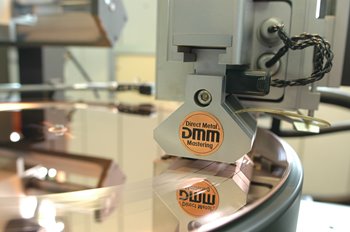Interested in learning a bit more about vinyl records? Here you’ll find some basic information, a video and a bit of history about the best format for music in the universe!
Enable GingerCannot connect to Ginger Check your internet connection
or reload the browserDisable in this text fieldRephraseRephrase current sentenceEdit in Ginger
Video about vinyl manufacturing
Interesting numbers regarding vinyl records
|
.jpg?width=350&height=232)
|
A standard 12-inch record usually weighs 120–150 grams, heavy weight records weigh 180-220 grams. One pressing cycle for a standard record typically lasts 20-30 seconds, but for heavy weight records it can last much longer. The dried labels and vinyl compound are pressed under a pressure of 100-150 tons at a temperature of 160°C (345°F). An LP typically contains 18-22 minutes of music per side. For a 20 minutes long side, the spiral groove is around 427 meters (467 yd.) long and consists of 667 threads. 2.23 seconds of audio is stored per square centimeter.
|
|
The basic width of the groove is approx. 0.04 – 0.08 mm (40 – 80 µm or 1.6 – 3 mil). If we cut the reference sinus signal 0 dB into the master plate, deviations of 0.0225 mm (22.5 µm = 0.886 mil) can be found when the groove is examined under a microscope. The cutting stylus vibrates 1000 times per second and is affected by an acceleration of 90 G! An object affected by such a high acceleration for 1 second would gain a speed of 2.6 Mach. Astronauts experience an acceleration of only around 6 G during taking off and landing of a space shuttle.
|

|
|

|
Lower level signals, which are 100 times (-40 dB) to 300 times (-50 dB) quieter, and are still part of the cut audio, have proportionately lower deviations – 0.000225 mm to 0.000075 mm (225 nm to 75 nm). These values are significantly lower than the wavelength of visible light, but such small details still have to be accurately transferred through the entire manufacturing process to the final pressed record.
Therefore, we can boldly say that manufacturing vinyl records is one of the most precise technologies of mass production.
|
As nice as your iPod might be for carrying in your pocket,
nothing will ever beat the rich, natural sound of a vinyl record!
GZ recommendations
VINYL CARE
Here is just a short list of tips that we recommend following when caring and storing for your vinyl records. There is also a lot more detailed information which can be found on the internet, but if you follow these simple tips – your records should last a lifetime!
Packing:
-
On the market, there is a large number of various types of standard inner sleeves available, ranging from paper to plastic. The most record-friendly types of sleeves are those which are either poly-lined or laminated on the inside, these prevent the dust from getting into the sleeve and hence keep the record protected.
-
GZ PREMIUM INNER SLEEVE - Inner lamination helps to protect your record from scratches.
Handling:
-
Never touch the recording surface or sensitive parts (grooves) of the vinyl – always handle it by the edges only. Make sure you have clean hands!
-
Always store your vinyl in its sleeve when you are not listening to it.
-
Most of all, keep your records away from dust!
-
Make sure that you have a quality turntable and a decent cartridge + stylus – playing records on cheap or damaged equipment can also damage your records.
Storage:
-
Keep your vinyl records in a cool dry place
-
Keep your records stacked vertically - never lay the vinyl records flat and do not stack your vinyl records one on top of the other. This can cause the vinyl record to warp over time.
-
Do not pack the records too tight on the shelve – make sure that there is a bit of room in-between each record
-
Always use plastic sleeves (plastic overbags) intended for storing vinyl records
-
Keep your records away from direct sunlight or sources of heat
Cleaning:
-
Keep your records clean! Always use a soft, non lint producing cloth or a carbon fiber brush
-
When playing your records on a turntable, it is recommended to keep the lid of the turntable closed to minimize the risk of dust collecting on the vinyl surface. Some people believe that this influences the sound quality, so its up to you to experiment what sounds better to you.
-
Your t-shirt is not a suitable cleaning cloth!
-
Keep your turntable mat clean
-
Keep your stylus clean
-
Try not to get the central labels wet when using a liquid record cleaner – this can cause the labels to tear over time
Enable GingerCannot connect to Ginger Check your internet connection
or reload the browserDisable in this text fieldRephraseRephrase current sentenceEdit in Ginger